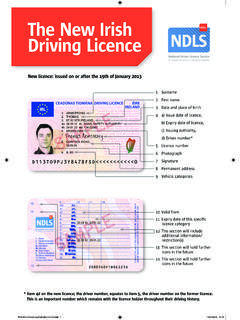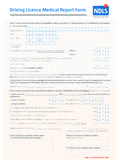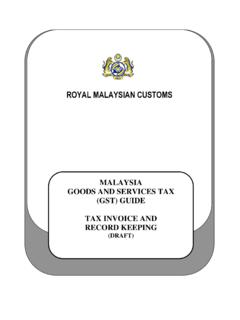Transcription of Guide to the road - RSA.ie
1 Dar s Um Sh bh ilteacht Ar Bh ithreRoad Safety AuthorityGuide to the roadTRAnSpoRT woRkinG Time diRecTive(diRecTive 2002/15/ec)23 XXX_RSA_a4_press+ 116/8/07 11:41:291contentswhat is the road Transport working Time directive? 2what obligations do employers and self-employed 3 drivers have?key Terms 6 About the road Transport working Time directive 11calculating working time and breaks 15enforcement and further information 21 Appendix 1 - Sample letter to inform employees of 22 road Transport working Time LegislationAppendix 2 - Sample workforce Agreement 28 Appendix 3 - Sample letter to employees concerning 31 work for another employer2what is the road Transport working Time directive?The road Transport working Time directive is the law which lays down the basic standards for how working time in the road transport sector is organised in eU countries.
2 The directive applies to all bus and truck drivers and other mobile workers who use tachographs for recording driving times, breaks and rest directive: places limits on working time, including night work, for mobile workers; specifies rest and breaks periods between work; and sets out the obligations of employers, workers and self-employed drivers in relation to record these measures, the directive seeks to: protect the health and safety of mobile workers in road transport; improve road safety; and harmonise conditions of competition.(Reference more detailed information on the working Time directive on page 11)This leaflet is aimed at employers and self-employed drivers. it outlines your obligations and explains some key terms related to the directive. it also explains the directive s main provisions and how they will be obligations do employers and self-employed drivers have?
3 If you re an employer, you have a number of obligations or responsibilities in relation to putting the road Transport working Time directive into practice. employers obligations are set out in Table 1 you re self-employed, you also have obligations with regard to the directive. Self-employed drivers obligations are set out in Table 1 Employer obligationsEmployer ObligationsAction to be takenYou must know which of your staff members are subject to the directive. make a list of all your mobile workers who are subject to the directive. Generally, this list will include drivers, crew and other travelling staff driving or travelling in vehicles fitted with must make sure your mobile workers are well informed about the advise each mobile worker of the key provisions of the directive and any collective agreements that apply to the worker (if relevant).
4 A sample letter for this purpose is included at the end of this leaflet Appendix could also keep your staff informed by putting the information in your company handbook. employees are required to declare that they have read and understood this employees need to be notified of the key provisions of the directive also. 4 Employer ObligationsAction to be takenYou must comply with the rules that apply to night work and reference periods. (There is a section further down in this leaflet which explains reference periods). decide if the night working limit needs to be extended. decide on the reference period for calculating the average weekly working time. p ut in place agreements with mobile workers concerning night working limits and reference periods. Formally advise mobile workers of the terms of the sample agreement for this purpose is included at the end of this leaflet Appendix 2 You must keep good records and be able to respond to employees queries.
5 Keep a record of hours worked by a mobile worker or any other information relating to the mobile worker s hours so that you can give them accurate information if they ask for it. You must hold on to records for future reference. keep working time records for at least two years after the end of the period they cover. Remember, this could mean that some records might be older than two years because of the beginning and ending of reference periods. You must be able to show your records to an enforcement officer at any time. working time records must be produced to an enforcement officer for each mobile worker upon demand. (Remember the two- year rule). if you are a mobile worker working through an employment agency and you are paid by the agency, they should keep your working time 2 Obligations of self-employed driversSelf-employed obligationsActions to be takenYou must keep up a simple system for recording your working time.
6 Include all work done for yourself as well as for any could be a combination of tachograph records and must comply with the rules about working time limits. make sure that you do not work more than 48 hours a week on average or more than 60 hours in a single week. make sure you obey the rules about daily and weekly rest periods and breaks. make sure you obey the night time rules. k eep track of your hours worked and reschedule the work if necessary to make sure working time limits are not broken. k eep good records of your working time to show that you are compliant with the must hold on to your records for future reference. keep working time records for at least two years after the end of the period they cover. Remember this could mean that some records might be older than two years because of the beginning and ending of reference periods.
7 You must be able to show your records to an enforcement officer at any time records must be produced to an enforcement officer upon demand. (Remember the two-year rule). if you need further information about any of these employer or self-employed obligations, you can contact the road Safety Authority at (091) termsWhat is a mobile worker?A mobile worker is any worker who is part of the travelling staff of a company or business that operates transport services: for passengers or goods, for hire or reward, or to carry out the company s own generally means drivers and crew members or any other travelling staff, and includes trainees and is a self-employed driver?A self-employed driver means: a driver who is entitled to work for themselves and who doesn t have a contract of employment; a driver who is free to choose the jobs they take on without being answerable to a boss or any other worker; a driver whose income depends directly on profits made rather than receiving a wage; a driver who is free to choose who they want to work for and with; a driver who is free to work for several customers if they wish;The amount of control the driver has over their work is a key point in determining if they are self employed, as is their reliance on profits to provide them with an is working time ?
8 W orking time is the time from the beginning to the end of work. during this time, the mobile worker is at their workstation, available to their employer and carrying out their: road transport functions, or other transport functions include the time spent on: driving; loading and unloading vehicles; assisting passengers getting on and getting off the vehicle; cleaning and technical maintenance; work to ensure the safety of the vehicle, its cargo and passengers; and administrative duties to meet any of the particular transport activity s legal or regulatory obligations, for example for customs or time spent on other activities includes: time during which the mobile worker cannot use their time freely and must be at their workstation ready to take up normal work; any waiting periods where the length of time is not known in the case of self-employed drivers, the same working time definition applies from the beginning to the end of work when the self-employed driver is at their workstation, at the disposal of a client or carrying out duties or activities other than general administrative work that is not directly linked to the job in time does not include: routine travel between home and the mobile worker s normal place of work, rest and breaks when no work is done, and periods of is a period of availability ?
9 Under the road Transport working Time directive, a period of availability is waiting time whose duration is known in advance by the mobile worker or self-employed driver. during this waiting time, the mobile worker or self-employed driver does not have to stay at their work station, but they must be available to: answer calls, start work or resume driving, carry out other of availability include, for example, time spent accompanying a vehicle being transported by train or ferry, time waiting at border crossings or delays due to traffic are some other examples. when a mobile worker arrives at work, they are told they will not be required to carry out any duties for a specified period but that they must remain on site to answer calls or be ready to take up work. if the mobile worker is told of a one-hour delay but is then told before the end of the first hour that a further delay of one hour is expected, then the second hour also counts as a period of availability.
10 Unless they re doing other work, the time spent by a relief driver travelling as a passenger would count as a period of availability - this time or part of it could also be treated as a break. if a driver knows that they are usually delayed at a shopping centre for an hour, this time counts as a period of availability. However, if the driver experiences a two-hour delay when they normally only expect one hour, the second hour is counted as working are breaks and rest periods ? Breaks are short intervals of at least 15 minutes duration when the worker stops their work activity completely. The worker or self-employed driver may use them only for recuperation that is, they must actually rest and not use the time to do other rest period is an unbroken period of time when the self-employed driver or worker is free to use their time as they mobile workers and self-employed drivers are subject to the break and rest provisions of eU Rules on drivers Hours when travelling.















